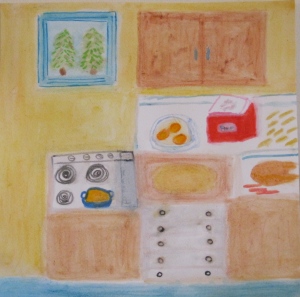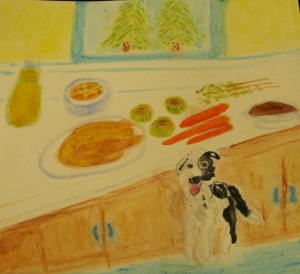One of ways I become a better cook is to learn from cooks with greater skill and different repertoires than I have: once such cook is Jane Garrett who cooks at Mabel Dodge Luhan House in Taos, New Mexico. On my most recent visit there on a snowy November afternoon Jane served a lunch that struck me as perfect for the season and the weather: marsala mushrooms over polenta served with fresh figs in a balsamic reduction. She accompanied this richness with a simple pan of roasted root vegetables and a lemony salad made of raw baby chard and radicchio. I no longer remember what we ate for dessert because it was the lunch dishes that captivated me.
I begged Jane for the recipes to share with you. She graciously obliged. I brought them home with me. I went out and bought a bottle of dry Marsala. Alas, fresh figs had disappeared from my Farmers’ Market: I bought some dried figs from Trader Joe’s and contented myself with mushrooms from the mushroom vendor. We keep polenta. The Riverdog Farm box yields plenty of leeks. I had all of the spices and herbs on hand.
I made three of the four lunch dishes for dinner tonight (We had no salad ingredients but romaine lettuce).
Because I was using dried figs, I began with the balsamic syrup, using the only balsamic vinegar I had on hand, a blackberry-vanilla blend I couldn’t resist a few years back: the small bottle sat at the back of our cooler cabinet, waiting for a compelling recipe. To make the syrup, combine
1 and 1/2 cups sugar
1/2 cup water
When sugar has dissolved, add
1/2 cup dark balsamic vinegar
1 cinnamon stick
1 piece of star anise
2 black peppercorns
1 allspice berry (I used about 1/2 tsp of ground allspice, being out of fresh)
rind of one orange, with juice (again, I faked it here, substituting some candied orange peel)
a few branches of dried thyme.
Jane says to simmer this for five minutes: since I was using dried figs I popped them into the syrup and let them simmer at very low heat while I cooked everything else.
I should have prepared the roasted vegetables next, but I chose to wipe about 3/4 of a pound of brown mushrooms first and clean 1 leek.
I sliced the leek into thin rings, put them through two changes of water, and skimmed them off to saute them in a skillet with olive oil and butter. While they cooked, I sliced the mushrooms, tossing any broken pieces into a stock pot with the trimmings from the leeks for vegetable stock.
When the leeks were browned, I transferred most of them into a bowl, added more oil and butter to the skillet and sauteed my mushrooms in two batches. I put one batch in with the leeks and left the other in the skillet on low heat. I splashed in some marsala and it all evaporated, so I waited and then added some more (Jane says to add it to taste and then thicken your sauce with cornstarch and vegetable stock). Then I put the other mushrooms back into it with just a few of the sauteed leeks and set the skillet aside so that I could prepare the vegetables I should have done earlier.
The vegetable compartment yielded parsnips, rutabaga and turnips. I peeled them, cut them bite-sized, more or less, poured a little olive oil in the palm of my hand and rubbed the vegetables with that on a sheet of foil in a roasting pan. I seasoned them with only a little black pepper — the other components are highly seasoned and I wanted the vegetables to contrast with the other elements. I put the parsnip tops and tails into my stock pot. As an afterthought I cut open a delicata squash and scooped the innards into my stock pot, added water and a few branches of thyme and started simmering the stock. I put the squash cut side down in a loaf pan I had rubbed with oil and put all of the vegetables into a 375-degree oven.
Then I made polenta: 1 cup of polenta to 4 cups of water and 1 tsp salt. Bring to a boil, stir regularly, and cook until thick.
All this time, my figs were simmering and my stock boiling, then simmering.
When the vegetables were almost done, I pulled them out of the oven and nuked them for two minutes in the microwave with a quarter cup of the unfinished stock — I did this because the rutabaga had been large and tough.
Then I heated up the mushrooms, made some liquid cornstarch by shaking cornstarch, stock and a bit of marsala in a small jar, scooped in a couple of teaspoons of the fig syrup and cooked the mixture for a few minutes.
Jane mounded her polenta in a serving dish, put the mushrooms on top and the balsamic figs around the sides. I kept the figs separate and instructed Mom to dish herself a pile of polenta, top it with mushrooms and eat the figs on the side if she wanted any. She did.
We both agreed that this dish would be better with the fresh figs that Jane had used, but it is the other end of November from when Jane made it — if you live in the Southern hemisphere, please make this with fresh figs, as I will earlier next fall. On the other hand, the balsamic syrup has a future on bowls of oatmeal and coffee ice cream, maybe on polenta pancakes!
Food Notes: Use fresh figs in this dish if they are available. Use any roastable vegetables you have on hand: carrots would be good, sweet potatoes, celery root. Use any kind of mushrooms you like, or a mixture of varieties. The Kensington Wine Shop says to buy “the good stuff,” dry marsala from Italy — apparently we don’t know how to make good marsala in California yet. Serve this with an acidic green salad if you possibly can — it takes the meal up a notch — but if you are fresh out of salad makings, make it anyway. You won’t be sorry. And if you get to Mabel’s, stop in and say “Hi” to Jane.
P.S. There was a little polenta left after the mushrooms were gone. This morning I mixed in an egg, some flour, some milk, a little sugar, 1 tsp of baking powder and a bit of vanilla and had some polenta pancake batter — apparently, I know how to do this without a recipe now. I ate the pancakes with some of the fig syrup — delicious!










